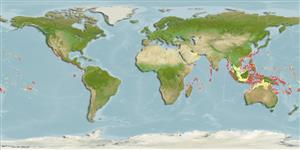Classification / Names
Common names from other countries
Main reference
Size / Weight / Age
Max length : 10.0 cm TL male/unsexed; (Ref. 9289)
Environment
Marine; reef-associated; depth range 1 - 40 m (Ref. 9710), usually 10 - 25 m (Ref. 27115)
Climate / Range
Tropical; 24°C - 28°C (Ref. 27115), preferred ?; 30°N - 23°S, 180°W - 180°E
Distribution
Indo-Pacific: Red Sea south to East London, South Africa (Ref. 5469) and east to the Marquesan Islands, north to the Mariana Islands, south to New Caledonia. Eastern Pacific: Gulf of California to Colombia and the Galapagos Islands (Ref. 9289).
Countries | FAO areas | Ecosystems | Occurrences | Introductions
Short description
Dorsal
spines
(total): 10;
Dorsal
soft rays
(total): 12-13;
Anal
spines: 3;
Anal
soft rays: 6. Highly variable in color from pale with grey to black blotches to pink with bright red blotches (Ref. 48636). Pale with horizontal rows of subquadrate dark brown spots; a row of smaller spots on LL between larger spots; small dark brown spots on head (Ref. 5469).
IUCN Red List Status (Ref. 115185)
Threat to humans
Harmless
Human uses
Aquarium: commercial
More information
ReferencesAquacultureAquaculture profileStrainsGeneticsAllele frequenciesHeritabilityDiseasesProcessingMass conversion
Tools
Special reports
Download XML
Internet sources
Estimates of some properties based on models
Phylogenetic diversity index
PD50 = 0.5039 many relatives (e.g. carps) 0.5 - 2.0 few relatives (e.g. lungfishes)
Trophic Level
4.0 ±0.66 se; Based on food items.
Resilience
Vulnerability
Low vulnerability (10 of 100)
Price category
